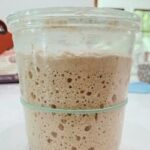How to Incorporate Wheat Germ into Sourdough Starter Feedings
Feeding your sourdough starter with wheat germ can add nutritional value and promote a stronger, more active starter. You can use freshly milled or store-bought wheat germ when feeding your starter. The below method uses the 1:2:2 method for feeding your starter. You could also use the 1:1:1 method. For the example below, I am using 50 grams of active starter, but using the 1:2:2 or 1:1:1 ratio you can double (or match) the grams of your starter to come up with the amount of flour and water for feeding. Use ~20% wheat germ once you know how much flour to use.
Cost: $0.00
Equipment
Materials
- 50 grams sourdough starter (active, fed, and ready for a new feeding)
- 80 grams all-purpose flour
- 20 grams wheat germ use freshly milled wheat germ if you have it
- 100 grams water 70-80 grams if you want a stiff starter
Instructions
- In a clean jar, weigh out your starter50 grams sourdough starter
- Add your dry flours on top of your starter, either visually or by weight using the 1:2 or 1:1 ratio80 grams all-purpose flour, 20 grams wheat germ
- Add water a little at a time until you reach the right weight or consistency.100 grams water
- Mix the ingredients thoroughly. The consistency should be thick but spreadable, similar to a thick pancake batter. Or extra stiff if you want less hydration.
- Cover with a loosely fitting lid to allow airflow while preventing debris from entering. I like to place my Weck glass jar lid cracked on top for this step.
- Let your starter sit at room temperature for 4-6 hours, or until it shows signs of bubbling and growth. You should see the mixture rise and develop small bubbles when it’s ready to be used.Or, refrigerate if not planning to use it within 4-6 hours. You could use the refrigerated starter within 24 hours, or plan to feed again within a few weeks.
Notes
-
Wheat Germ Percentage:
The wheat germ provides extra nutrition for your starter, and adjusting the percentage (from 10-25%) allows you to experiment with different flavor profiles and fermentation activity. For a slightly milder taste, stay closer to the 10% range; for a more robust flavor, use 25%. -
Water Temperature:
Use room temperature water for the feeding. Too hot or cold water can shock the starter, affecting fermentation rates. Lukewarm water (around 75°F/24°C) is optimal if you're looking to speed up the process a little. -
Consistency:
Aim for a consistency that’s a little thicker than pancake batter. If the mixture feels too dry, add a small splash of water to loosen it up. Conversely, if it’s too runny, add a bit more flour. -
Storage:
If you aren’t baking immediately, you can refrigerate your starter after it has fermented for the day. It will slow the fermentation process, and you can resume feeding it every 24-48 hours to maintain its health. -
Float Test/Next Steps:
After your starter has fermented and is bubbly, you can use it in baking or feed it again to strengthen it further for the next batch. Your starter should be bubbly, and when you test it (by dropping a small spoonful in water), it should float.
